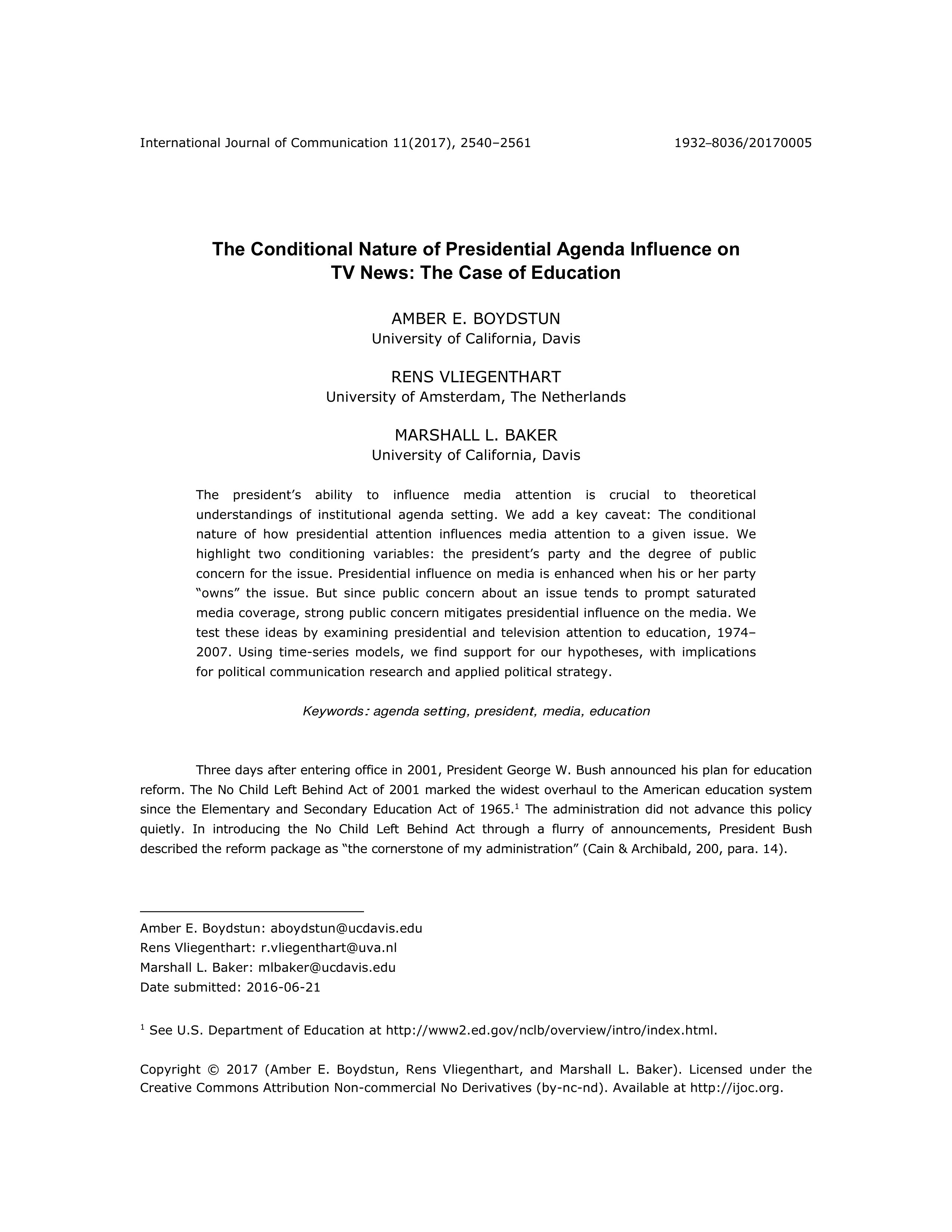Thư viện tri thức trực tuyến
Kho tài liệu với 50,000+ tài liệu học thuật
© 2023 Siêu thị PDF - Kho tài liệu học thuật hàng đầu Việt Nam

Tài liệu đang bị lỗi
File tài liệu này hiện đang bị hỏng, chúng tôi đang cố gắng khắc phục.
The Conditional Nature of Presidential Agenda Influence on TV News
Nội dung xem thử
Mô tả chi tiết
International Journal of Communication 11(2017), 2540–2561 1932–8036/20170005
Copyright © 2017 (Amber E. Boydstun, Rens Vliegenthart, and Marshall L. Baker). Licensed under the
Creative Commons Attribution Non-commercial No Derivatives (by-nc-nd). Available at http://ijoc.org.
The Conditional Nature of Presidential Agenda Influence on
TV News: The Case of Education
AMBER E. BOYDSTUN
University of California, Davis
RENS VLIEGENTHART
University of Amsterdam, The Netherlands
MARSHALL L. BAKER
University of California, Davis
The president’s ability to influence media attention is crucial to theoretical
understandings of institutional agenda setting. We add a key caveat: The conditional
nature of how presidential attention influences media attention to a given issue. We
highlight two conditioning variables: the president’s party and the degree of public
concern for the issue. Presidential influence on media is enhanced when his or her party
“owns” the issue. But since public concern about an issue tends to prompt saturated
media coverage, strong public concern mitigates presidential influence on the media. We
test these ideas by examining presidential and television attention to education, 1974–
2007. Using time-series models, we find support for our hypotheses, with implications
for political communication research and applied political strategy.
Keywords: agenda setting, president, media, education
Three days after entering office in 2001, President George W. Bush announced his plan for education
reform. The No Child Left Behind Act of 2001 marked the widest overhaul to the American education system
since the Elementary and Secondary Education Act of 1965.1 The administration did not advance this policy
quietly. In introducing the No Child Left Behind Act through a flurry of announcements, President Bush
described the reform package as “the cornerstone of my administration” (Cain & Archibald, 200, para. 14).
Amber E. Boydstun: [email protected]
Rens Vliegenthart: [email protected]
Marshall L. Baker: [email protected]
Date submitted: 2016-06-21
1 See U.S. Department of Education at http://www2.ed.gov/nclb/overview/intro/index.html.
International Journal of Communication 11(2017) Conditional Nature of Presidential Agenda Influence 2541
By contrast, education was an important policy issue for President Bill Clinton, but arguably not
as important as it would later be for President Bush. The Clinton administration produced no policy
initiative approaching the magnitude of No Child Left Behind, and although Clinton talked about education
a fair amount, he gave the issue much less attention than Bush later would. Comparing the first eight
months of the two presidencies (so as to capture the pre-9/11 period for Bush) using the Public Papers of
the President data that we describe below, Bush spent four times as much agenda space on education as
did Clinton.2 So keen was the Bush administration on the success of its education policy, even amidst
more immediate foreign policy considerations, that in 2004 the Department of Education paid prominent
conservative pundit Armstrong Williams $241,000 to promote the Bush education initiatives in the news
(Kurtz, 2005).
Yet the media did not pick up on education in proportion to the attention given the issue by these
two presidents. Network TV gave barely half as much airtime to education during Bush’s presidency as it
did during Clinton’s presidency, based on data we introduce below.3 Even when we look at the first eight
months of the Bush administration when Bush was unveiling the No Child Left Behind policy (again, before
9/11 shifted available agenda space), there was 14% less network news coverage about education
compared with Clinton’s first eight months.4 Why? While we can only go so far in inferring from a
president’s attention to an issue a desire to draw media (and, thus, public) attention to the issue, it is
reasonable to consider President Bush’s attention to education as a strategic “going public” endeavor
(Kernell, 2006). In this framework, why was Bush less successful at influencing the media agenda than
Clinton?
The discrepancy in the levels of media coverage paid to education during these two presidencies
points to a larger question underpinning theories of agenda setting: What variables condition the influence
of one agenda (e.g., presidential attention) on another (e.g., the media)?
To be clear, presidents do not always want their attention to an issue to get picked up by the
media. Indeed, much of a president’s communication occurs behind the scenes, operating intentionally out
of view of the media and the public. Scholars such as Beasley (2010) and Nelson (2008) describe the
important role these intergovernmental “unitary executive” functions play, in tandem with the publicly
aimed “rhetorical presidency” that presidents use by going public. Still, presidents routinely employ a
rhetorical presidency approach—taking their messages to the public, via the press—when they think public
2 We can compare the levels of attention the two presidents gave to education by searching for the word
education within the UCSB Public Papers of the President archive (Peters & Woolley, 2007). Bush made
4,052 references during his first eight months, representing on average 0.4% of his agenda space (i.e., all
words in his presidential papers) during this period, compared with 2,840 references by Clinton,
representing 0.1% of his agenda space. Even considering the full presidencies, with the Bush
administration spending vast agenda space on Afghanistan and Iraq, Bush still gave a slightly higher
proportion of his total attention to education (0.266% of his agenda space) than did Clinton (0.235% of
his agenda space).
3 Network TV spent 44 hours on education during Bush’s administration, compared with 82 hours for Clinton.
4 About six hours during Bush’s first eight months, compared with seven hours for Clinton.